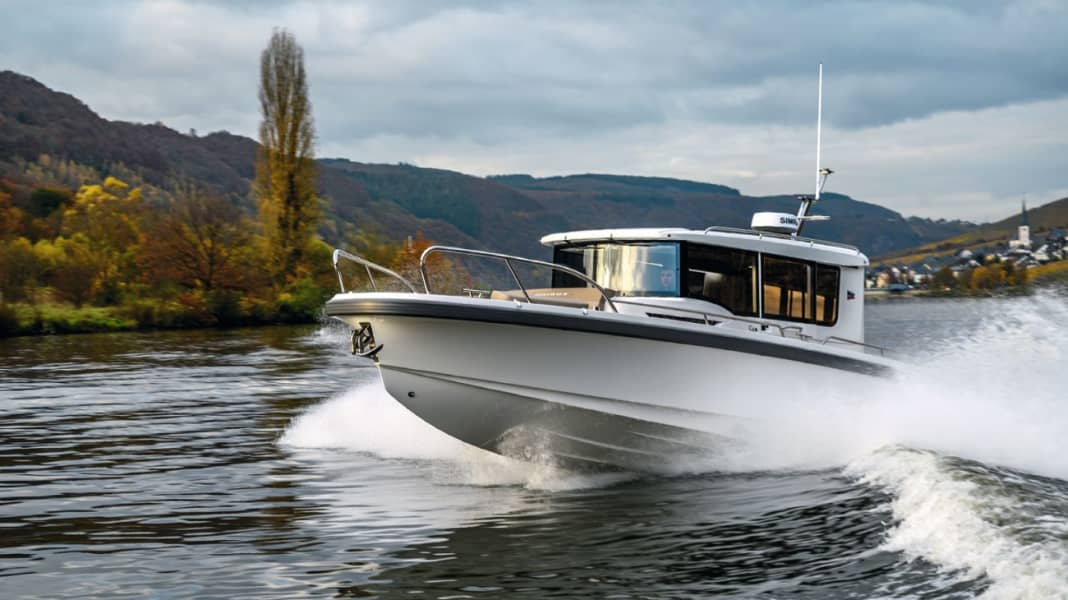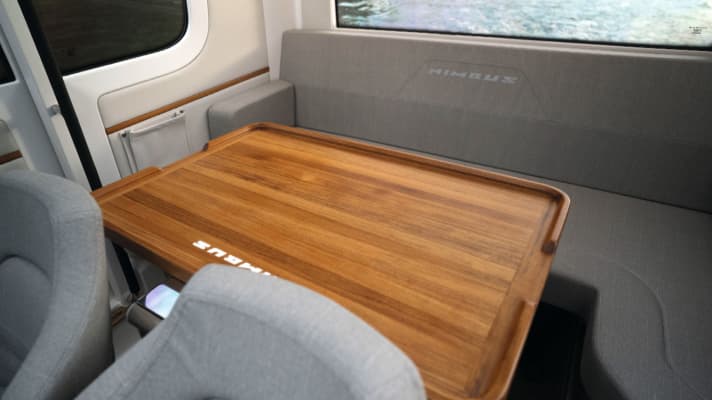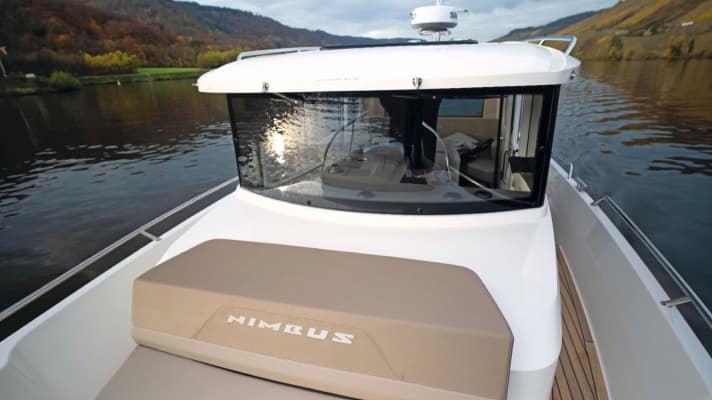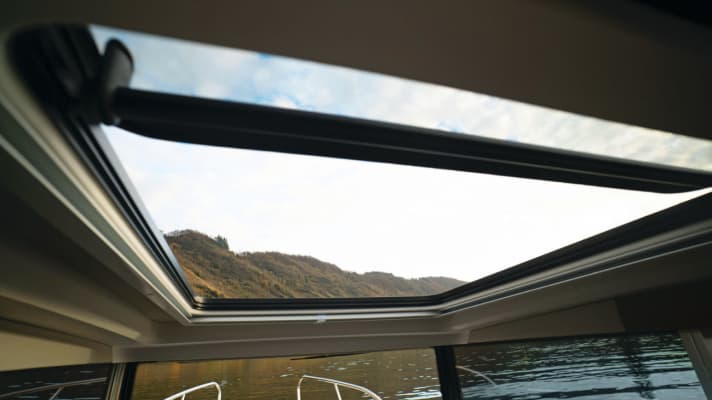
The Nimbus brand from Sweden stands for quality and elegance. Clear, simple lines and a stylish colour scheme define the look, with three dominant colours: White, grey and brown. White hulls, grey decorative stripes, brown teak. However, it is not only the design that is straightforward, but also the type designations. Scandinavian simplicity - to differentiate the boats, Nimbus simply adds a W, T or C to the rounded length in metres. The letters describe the intended use: weekender, tender or commuter. While weekenders or tenders are also found as a type at other shipyards, hardly any of them use the term commuter. The commuter boat is inevitably reminiscent of the golden 1920s, when famous New York businessmen from Astor to Vanderbilt travelled to work in Manhattan in the morning on commuter boats. Their large summer villas were located out on Long Island Sound or the upper Hudson River, so the boats had three characteristics: they were narrow, long and fast, and they had a sheltered deckhouse with windows all round.
But commuter boats were not only useful in New York in the 1920s - such boats are also extremely popular in Sweden, where the country has over 260000 islands, many of which are home to holiday homes or cabins that need to be reached dry and warm in both summer and winter. That is why the new Nimbus C9 has the same characteristics as the commuter boats of 100 years ago: It is comfortable, seaworthy and enables pleasant crossings even in unpleasant weather. At the same time, with a spacious slip cabin including a fully-fledged toilet room, it offers the possibility of taking the boat on day trips or multi-day trips for two.
The boat
- Shipyard: Nimbus Boats/Sweden
- Type: C9
- CE category: C, 8 persons
- Hull and deck: plastic
- Overall length: 9.35 m
- Width: 2.95 m
- Displacement: approx. 3300 kg
- Clearance height: 2.65 m
- Fuel tank: 320 litres
- Water tank: 80 litres
- Holding tank: 40 litres
- Berths: 2
- Berth dimensions at the front: 1.90 x 1.90 m
- Standing height/seat height: Cabin 1.50 m/0.69 m; washroom 1.51 m; driver's cab 1.98 m
- Cockpit size: 2.40 m x 1.56 m
- Sunbeds: Foredeck 2.20 m x 1.16 m; stern 1.46 x 1.24 m
- Freeboard: 0.70 m or 0.30 m (open stern)
- Interior cockpit side height: 0.62 m
- Turning circles (boat lengths): forwards starboard 1, port 1; astern starboard 1.5, port 1.5
- Reverse: from starboard to port 5 s; from port to starboard 5 s
- Test weight: approx. 3600 kg
- max. motorisation: outboard/inboard 255 kW (350 hp)
- Test engine: 1 x Mercury Diesel 3.0L, 198 kW (270 hp)
- Price (standard boat with test engine): €227,000
- Dealer: Boote Polch KG, Zum Hafen 18, 56841 Traben-Trarbach, www.bootepolch.de
The Nimbus C9 is available with a wide range of engines, both with an outboard motor between 250 and 350 hp and with a diesel between 270 and 350 hp. The boat we tested has a Mercury diesel with 270 hp, 3 litre displacement and Bravo3 drive. The V6 is mounted with exemplary finish in the engine compartment under the rear sunbed and fills the space to such an extent that it is hard to imagine how a V8 Volvo Penta, which is also available, would fit in here. Only the gas pressure spring is a little weak and reaches its limits when holding the hatch up.

The very first step on board makes you realise that you are on board a Nimbus, a luxury-class ship. Wherever you look, whatever you touch: the highest quality materials have been used everywhere, from the teak deck to the suede appliqué on the dashboard. There is enough space in the cab for five passengers, who can be accommodated on a three-seater bench seat in the rear and two bucket seats. On cold days like this one, the deckhouse with its many windows creates a sheltered and cosy feeling and also offers a good all-round view. To prevent this from turning into a feeling of oppression on hot days when the weather is nice and you have to sit inside, the sliding doors and the large roof hatch can be opened on both sides. A fold-up teak table and two swivelling front seats transform the deckhouse into a comfortable conservatory with a seating area in no time at all. The wide bench can also be folded down to create a double berth for two children.
The dashboard is dominated by a large 16-inch Simrad plotter (alternatively: two 12-inch plotters), which is not only responsible for displaying the nautical charts, but also for displaying all engine information. In addition, a Zipwake panel and a Fusion sound system are located to the left of the leather-covered steering wheel, with the switch for the bow thruster on the right and a VHF radio in the stowage box. There are also plenty of 12-volt and USB sockets. All important consumers can be activated via push-button switches.
On our cold test day, we start by looking for the heating control panel, which is actually found on every Scandinavian boat and is located in the small slip cabin on the Nimbus C9. Strangely enough, the air outlet near the driver is directed exactly towards the helm position 10 cm away instead of into the room. The heating is running, and thanks to its own air vents on the windscreen, it shouldn't take long for the cab to warm up and the windows to be free of condensation.

In the meantime, we take a closer look at the cabin, which really can be described as such. Although the berths are not very long at 1.90 metres, they are at least very comfortable at 1.90 metres wide. A wide hatch above the foot end provides safety as an emergency exit and is also very practical when the berth cushions are transported below deck from the foredeck. On the left-hand side of the cabin there is a small galley with a sink and a work surface on which a small cooker could also be installed. When not in use, it is covered by a sturdy teak plywood panel with two stainless steel handles. However, it would be better if the top could be locked. Because in rough seas, people will probably try to grab hold of these handles - and then pull the whole panel down. The toilet room is very spacious for the size of the boat, 1.51 metres high, heated, but unfortunately without ventilation. The sometimes necessary "exhaust air" can therefore only escape through the cab.
Not only is the build quality of the Nimbus C9 exceptionally good, the installation of the individual components and equipment is also exemplary. The diesel tank can be reached under two watertight covers and has shut-off valves for both the supply and return lines. All hoses are also fitted with two clamps and, in addition to a manual fire extinguisher under the helm seat, there is an automatic extinguishing device in the engine room with a status light at the helm.

After the Nimbus C9 had already made a very good impression on the jetty, we naturally wanted to experience the boat on the water. At just over nine metres in length, it is still a boat with manageable dimensions, but with a width of almost three metres and a weight of over three tonnes, it sits very firmly and comfortably in the water and allows a lot of payload. Even when casting off and stowing fenders and lines, good proportions are noticeable. The distances between the superstructure and the coaming are optimised so that you can move easily around the boat, but the design is not overly bulky despite the large cab. The two-stage hull shape creates air cushions under the hull that reduce friction on the water, which reduces fuel consumption and increases speed at the same time. At slow displacement speeds, the Nimbus C9 yaws a little, but stabilises again at fast displacement speeds around 1300-1400 rpm and has good course stability. At a speed of around 7.5 knots, this results in a range of a good 270 nautical miles (plus 15 per cent reserve). With the trim electronics (zipwake) switched off, the boat pulls the nose up a little when transitioning to planing (2800 to 3000 rpm), but the visibility restrictions are minimal. The C9 achieves a good planing speed at 3500 rpm and just under 30 knots, whereby it then has a range of around 173 nautical miles with a consumption of just 1.57 litres per nautical mile. If you accelerate the boat to its top speed of 37 knots at 4000 rpm, the fuel consumption and range hardly change. The handling with and without trim is very pleasant, the Nimbus 9C performs tight turns and evasive manoeuvres with flying colours and turns forwards during harbour manoeuvres with a turning circle of one boat length. However, when reversing quickly, water quickly gets on board - as you would expect with the open stern.
Conclusion
The Nimbus C9 is not only suitable as a commuter boat to a private island, but for anyone who would like to have a boat with which they can extend the season and go out on the water in any weather - whether in sun or snow. With an almost unrivalled build quality and a price of 227,000 euros, this boat is clearly in the upper class and is extremely successful both in terms of its design and the thoughtfulness of many detailed solutions.
Need more information? The test of the Nimbus C9 can be found with further pictures, measurement results and full evaluation in BOOTE issue 03/2022 - available at newsstands since 16 February 2022 or online at Delius Klasing Shop.

